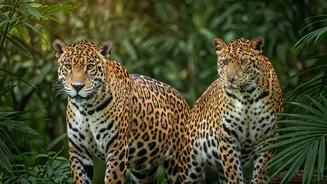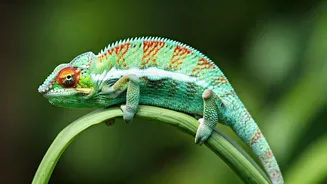Spotting the Visual Differences
Identifying jaguars and leopards visually relies heavily on understanding their unique markings. Leopards are typically smaller, with a body length ranging
from 3 to 6 feet, and they weigh between 66 to 200 pounds. Jaguars, on the other hand, are larger, measuring 4 to 6 feet in length and weighing 100 to 250 pounds. A key difference lies in their spots: leopards have rosettes – spots with a ring-like pattern, while jaguars also have rosettes, but with spots inside the rings. Jaguar rosettes also tend to be larger and fewer than those of a leopard. The color of their fur also differs. Leopards have pale yellow or tawny coats. Jaguars have a coat that is usually tawny, and they have black spots and rosettes. Melanistic jaguars and leopards (black panthers) also exist, which are completely black due to a higher concentration of melanin, making visual differentiation based on spots impossible; however, by observing their built and shape, it is still possible to tell the difference.
Habitat and Range
The environments in which these big cats thrive differ significantly. Leopards have a broader habitat range, found in various ecosystems across Africa and Asia. They adapt well to woodlands, grasslands, savannas, and even mountainous regions, which supports their survival. Jaguars, however, are primarily native to the Americas. Their habitat is mainly the rainforests and wetlands of South and Central America, although they sometimes venture into grasslands and scrublands. Jaguars are more closely tied to water sources than leopards, thus preferring dense vegetation near rivers, swamps, and other waterways. The habitats of both big cats are undergoing threats; the loss of the natural habitats is one of the main factors putting these cats at risk. This factor reduces the hunting areas, decreases the food availability, and forces the cats to approach human settlements more often.
Behavior and Hunting Styles
The behavior and hunting strategies of jaguars and leopards highlight how they've adapted to their respective environments. Leopards are generally solitary animals, except during mating. They are highly adaptable hunters, skilled at ambushing prey and capable of hunting by night. Their diet includes various animals, from insects to larger mammals, and they often drag their kill into trees to protect it from scavengers. Jaguars are also solitary hunters and are skilled ambush predators, which gives them a high hunting success rate. They are known for their powerful bite, which they use to pierce the skulls of their prey, and they are strong swimmers that hunt aquatic animals as well. Jaguars, like leopards, also show territorial behavior, marking their territories with scent markings and vocalizations to ward off other jaguars. However, the exact behavior changes from region to region, and even from individual to individual. For example, some jaguars have been observed to exhibit diurnal behaviour.











